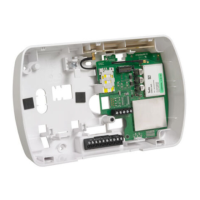
Do you have a question about the DSC 3G2075 and is the answer not in the manual?
| Network Technology | GSM / HSPA |
|---|---|
| 3G bands | HSDPA 850 / 1900 / 2100 |
| GPRS | Yes |
| EDGE | Yes |
| Multitouch | Yes |
| Alert types | Vibration; MP3, WAV ringtones |
| Loudspeaker | Yes |
| 3.5mm jack | Yes |
| WLAN | Wi-Fi 802.11 b/g/n, hotspot |
| GPS | Yes, with A-GPS |
| Messaging | SMS(threaded view), MMS, Email, Push Email, IM |
| Browser | HTML |
| 2G bands | GSM 850 / 900 / 1800 / 1900 |
| Speed | HSPA |
| Status | Available |
| SIM | Mini-SIM |
| Type | TFT |
| Video | Yes |
| Bluetooth | A2DP |
| Radio | FM radio |
| USB | microUSB 2.0 |
| Battery | Li-Ion |
| Colors | Black |
| Expandable Memory | microSD, up to 32 GB |
| Model | 3G2075 |
Covers general system failures, component issues, installation, and testing.
Covers limitations of motion detectors, power, smoke detectors, telephone lines, and warning devices.
Explains how data is displayed and entered on the keypad.
Covers mounting considerations and safety warnings.
Describes the 3G2075 and TL2753G models and their capabilities.
Lists primary functionalities, features, and UL/ULC installation needs.
Details electrical specifications and compatible hardware.
Covers essential steps for setting up the communicator before installation.
Explains AES encryption and initial configuration with the panel.
Provides instructions for handling the SIM card and CAT5 cable.
Covers final SIM card steps and how to reset the communicator.
Details how to establish a communication channel with the SCW9055/SCW9057 panel.
Step-by-step guide for testing signal strength at the installation location.
Explains how to interpret signal levels using bars and dBm values.
Covers IP, Subnet, Gateway, Supervision Interval, and Supervision Types.
Covers path, redundant comms, firmware upgrades, DLS, DNS settings.
Installer code, DLS incoming/outgoing ports.
Time zone, Communications Format.
Account code and specific event reporting codes.
Configures test transmissions to primary/secondary receivers.
Configures reporting for firmware update events.
Configuration options for the first Ethernet receiver.
Configuration options for the second Ethernet receiver.
Configures Ethernet test transmission time and cycle.
Sets up account and DNIS for the first cellular receiver.
Configures address and port for cellular receivers.
Sets up APN and domain name for cellular connectivity.
Covers cellular login, test transmission time/cycle.
Configures trouble delay and voice call timeout/callback.
Allows forcing test transmissions for diagnostics.
Displays various system parameters like versions, IP addresses, and SIM details.
Displays IMEI and MAC addresses.
Explains options for resetting the module to default settings.
Explains the meaning of status codes and indicators.
Details the status of the radio initialization process.
Provides detailed status and completion bits for radio initialization.
Lists common trouble codes, their causes, and solutions.
Explains signal strength levels and associated actions.
Details the meaning of network indicator codes.
Fields for System Options, Programming Options, and Test Options.
Fields for Ethernet Receiver 1 and 2 settings, and Ethernet Options.
Fields for Cellular Receiver 1 and 2 settings, and Cellular Options.
Fields for System Information (Read Only).
Fields for System Reset Defaults.
Terms granting rights and limitations for software use.
Details on limitations of liability and exclusive remedies.
Covers warranty period, conditions, and items not covered.
Outlines the process for warranty claims and disclaimers.
Details FCC and Industry Canada statements and warnings.
